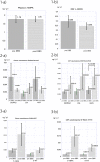Subthalamic Nucleus Deep Brain Stimulation Modulate Catecholamine Levels with Significant Relations to Clinical Outcome after Surgery in Patients with Parkinson's Disease
- PMID: 26394059
- PMCID: PMC4578924
- DOI: 10.1371/journal.pone.0138462
Subthalamic Nucleus Deep Brain Stimulation Modulate Catecholamine Levels with Significant Relations to Clinical Outcome after Surgery in Patients with Parkinson's Disease
Abstract
Aims: Although subthalamic nucleus deep brain stimulation (STN-DBS) is effective in patients with advanced Parkinson's disease (PD), its physiological mechanisms remain unclear. Because STN-DBS is effective in patients with PD whose motor symptoms are dramatically alleviated by L-3,4-dihydroxyphenylalanine (L-DOPA) treatment, the higher preoperative catecholamine levels might be related to the better clinical outcome after surgery. We aimed to examine the correlation between the preoperative catecholamine levels and postoperative clinical outcome after subthalamic nucleus deep brain stimulation. The effectiveness of STN-DBS in the patient who responded well to dopaminergic medication suggest the causal link between the dopaminergic system and STN-DBS. We also examined how catecholamine levels were modulated after subthalamic stimulation.
Methods: In total 25 patients with PD were enrolled (Mean age 66.2 ± 6.7 years, mean disease duration 11.6 ± 3.7 years). Mean levodopa equivalent doses were 1032 ± 34.6 mg before surgery. Cerebrospinal fluid and plasma catecholamine levels were measured an hour after oral administration of antiparkinsonian drugs before surgery. The mean Unified Parkinson's Disease Rating Scale scores (UPDRS) and the Parkinson's disease Questionnaire-39 (PDQ-39) were obtained before and after surgery. Of the 25 patients, postoperative cerebrospinal fluid and plasma were collected an hour after oral administration of antiparkinsonian drugs during on stimulation at follow up in 11 patients.
Results: Mean levodopa equivalent doses significantly decreased after surgery with improvement in motor functions and quality of life. The preoperative catecholamine levels had basically negative correlations with postoperative motor scores and quality of life, suggesting that higher preoperative catecholamine levels were related to better outcome after STN-DBS. The preoperative plasma levels of L-DOPA had significantly negative correlations with postoperative UPDRS- III score in off phase three months after STN-DBS. The preoperative cerebrospinal fluid (CSF) 3,4-dihydroxyphenylacetic acid (DOPAC) and 5-hydroxytryptamine (5-HT) levels had significantly negative correlations with postoperative UPDRS- III score in off phase one year after STN-DBS and the preoperative CSF homovanilic acid (HVA) levels had significant negative correlations with postoperative UPDRS- III score in on phase three months after STN-DBS. In PDQ-39 SI (summary index), preoperative plasma dopamine (DA) level had significantly negative correlations with postoperative PDQ-39 SI one year after STN-DBS suggesting that higher preoperative plasma DA level resulted in better quality of life (QOL) one year after STN-DBS. The stepwise multiple linear regression study revealed that higher preoperative plasma HVA levels had negative influence on the postoperative motor symptoms (i.e., increase in the score of UPDRS), whereas higher preoperative CSF L-DOPA levels had positive influence on the postoperative motor symptoms and QOL (decrease in the score of UPDRS and PDQ-39 SI) The catecholamine levels were not significantly reduced postoperatively in 11 patients despite the significant reduction in levodopa equivalent doses. Unexpectedly, CSF HVA levels significantly increased from 0.00089±0.0003 ng/μl to 0.002±0.0008 ng/μl after STN-DBS.
Conclusion: The preoperative catecholamine levels might affect the postoperative motor symptoms and quality of life. The catecholamine levels were not significantly reduced postoperatively despite the significant reduction in levodopa equivalent doses.
Conflict of interest statement
Figures

Similar articles
-
Quality of life in advanced Parkinson's disease after bilateral subthalamic stimulation: 2 years follow-up study.Clin Neurol Neurosurg. 2014 Sep;124:161-5. doi: 10.1016/j.clineuro.2014.06.019. Epub 2014 Jun 23. Clin Neurol Neurosurg. 2014. PMID: 25051167
-
Long-term impact on quality of life of subthalamic nucleus stimulation in Parkinson's disease.J Neurol. 2016 May;263(5):895-905. doi: 10.1007/s00415-016-8077-4. Epub 2016 Mar 10. J Neurol. 2016. PMID: 26964542
-
Clinical outcomes using ClearPoint interventional MRI for deep brain stimulation lead placement in Parkinson's disease.J Neurosurg. 2016 Apr;124(4):908-16. doi: 10.3171/2015.4.JNS15173. Epub 2015 Oct 23. J Neurosurg. 2016. PMID: 26495947
-
Subthalamic nucleus deep brain stimulation: summary and meta-analysis of outcomes.Mov Disord. 2006 Jun;21 Suppl 14:S290-304. doi: 10.1002/mds.20962. Mov Disord. 2006. PMID: 16892449
-
Congress of Neurological Surgeons Systematic Review and Evidence-Based Guideline on Subthalamic Nucleus and Globus Pallidus Internus Deep Brain Stimulation for the Treatment of Patients With Parkinson's Disease: Executive Summary.Neurosurgery. 2018 Jun 1;82(6):753-756. doi: 10.1093/neuros/nyy037. Neurosurgery. 2018. PMID: 29538685 Free PMC article.
Cited by
-
The role of neurotransmitter systems in mediating deep brain stimulation effects in Parkinson's disease.Front Neurosci. 2022 Oct 5;16:998932. doi: 10.3389/fnins.2022.998932. eCollection 2022. Front Neurosci. 2022. PMID: 36278000 Free PMC article. Review.
-
The safety profile of subthalamic nucleus and globus pallidus internus deep brain stimulation for Parkinson's diseases: A systematic review of perioperative complications and psychological impacts.Langenbecks Arch Surg. 2025 Apr 17;410(1):131. doi: 10.1007/s00423-025-03674-z. Langenbecks Arch Surg. 2025. PMID: 40244330 Free PMC article.
References
-
- Kringelbach ML, Jenkinson N, Owen SL, Aziz TZ. Translational principles of deep brain stimulation. Nat Rev Neurosci. 2007;8:623–635. - PubMed
MeSH terms
Substances
LinkOut - more resources
Full Text Sources
Other Literature Sources
Medical

